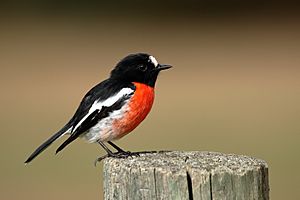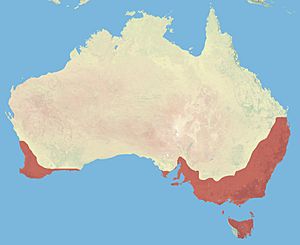Scarlet robin facts for kids
Quick facts for kids Scarlet robin |
|
|---|---|
 |
|
| Male | |
 |
|
| Female | |
| Conservation status | |
| Scientific classification | |
| Genus: |
Petroica
|
| Species: |
boodang
|
 |
|
| Distribution map | |
| Synonyms | |
|
Petroica multicolor boodang |
|
The scarlet robin (Petroica boodang) is a small, colorful bird. It is a type of Australasian robin found in Australia. These birds are known for their bright red chests. They live on the Australian mainland and nearby islands, like Tasmania. Scientists officially recognized the scarlet robin as its own species in 1999. Before that, it was grouped with the Norfolk robin.
Contents
About the Scarlet Robin's Family
The scarlet robin belongs to a group of birds called Petroica boodang. There are three main types, or subspecies, of scarlet robins.
- P.b.boodang lives in southeastern Australia.
- P.b.leggii is found in Tasmania and Flinders Island.
- P.b.campbelli lives in southwestern Western Australia.
What Scarlet Robins Look Like
Scarlet robins are small, sturdy birds with large heads. They are about 12 to 13.5 centimeters (about 5 inches) long. They weigh only about 12 to 14 grams, which is like two small candies.
Male and female scarlet robins look different. This is called sexual dimorphism.
- Males have black heads, backs, and tails. Their wings are black and white. They have a bright, scarlet red chest and a white belly. Their forehead and rump (the area above their tail) are also white.
- Females have a similar pattern but are duller. Their black parts are brown, and their red chest is much lighter. Their belly is a light, yellowish-brown color.
Young scarlet robins look like the female, but they do not have the reddish color on their chest.
Where Scarlet Robins Live and Travel
The scarlet robin is a bird that lives only in Australia. This means it is endemic to Australia. You can find them near the coast from southern Queensland to central South Australia. They also live in Tasmania and southwest Western Australia.
Most scarlet robins stay in the same area all year. However, some birds on the mainland might move short distances in autumn and winter. They might go to more open areas or lower lands.
These birds usually live in eucalyptus forests and woodlands. They prefer places with open spaces, grassy areas, and small bushes. In winter, they might visit more open places, even cities and towns.
How Scarlet Robins Behave
Scarlet robins eat small creatures like insects and spiders. They change how they hunt depending on the season. In winter, they mostly look for food on the ground. But in summer and spring, they often catch prey from tree bark and leaves.
Reproduction and Life Cycle
Scarlet robins are territorial birds. This means they protect their nesting area from other robins. They are also monogamous, meaning a male and female pair stay together for breeding. They start building nests and laying eggs before other similar birds, like the flame robin, arrive in the area.
Both the male and female help choose where to build the bird nest. However, only the female builds the nest, which takes her about four to ten days. A female usually lays one to four eggs, but three is most common. The eggs can be grey, green, or light blue. They have brown or olive-brown spots, usually more at one end.
Only the female sits on the eggs to keep them warm, a process called incubation. The male brings food to the female while she is on the nest. The chicks hatch after 14 to 18 days. At first, the female keeps the chicks warm, and the male feeds them. Once the chicks are older, both parents feed them.
It can be hard for scarlet robin nests to succeed. Only about 8% to 40% of nests are successful. Snakes sometimes raid their nests. Also, some types of cuckoo birds lay their eggs in scarlet robin nests. This is called brood parasitism. The cuckoo chicks then get raised by the robin parents.
Gallery
Images for kids
See also
 In Spanish: Petroica escarlata para niños
In Spanish: Petroica escarlata para niños








